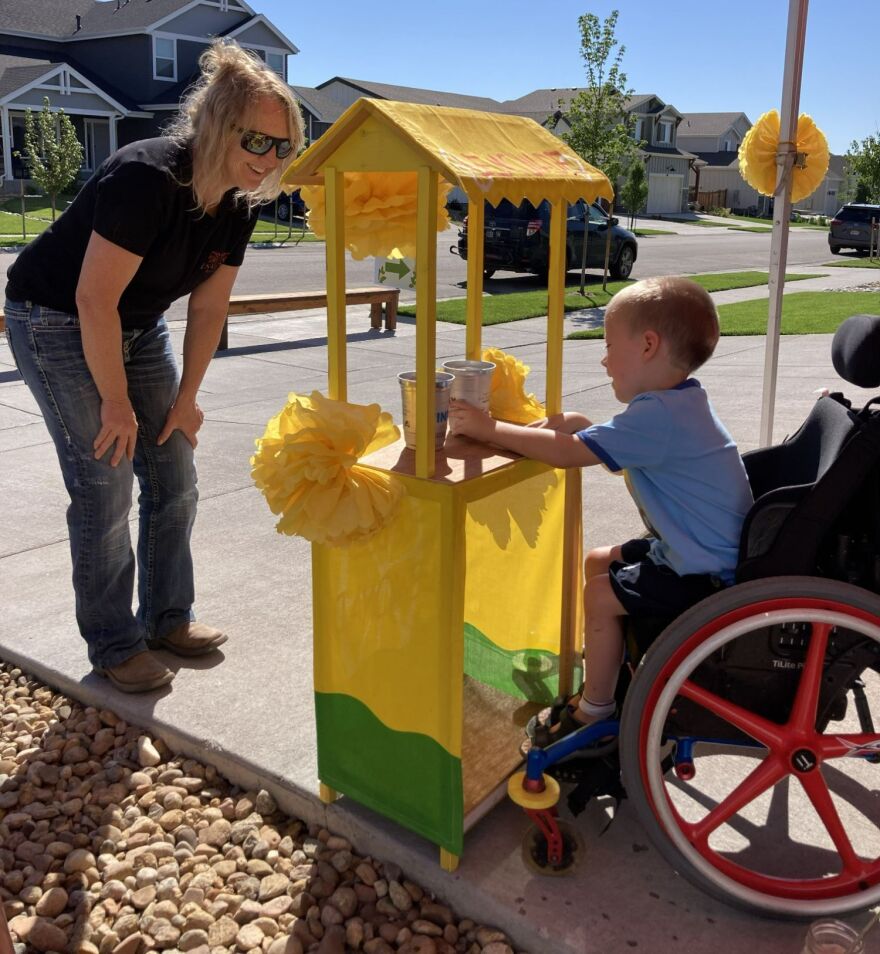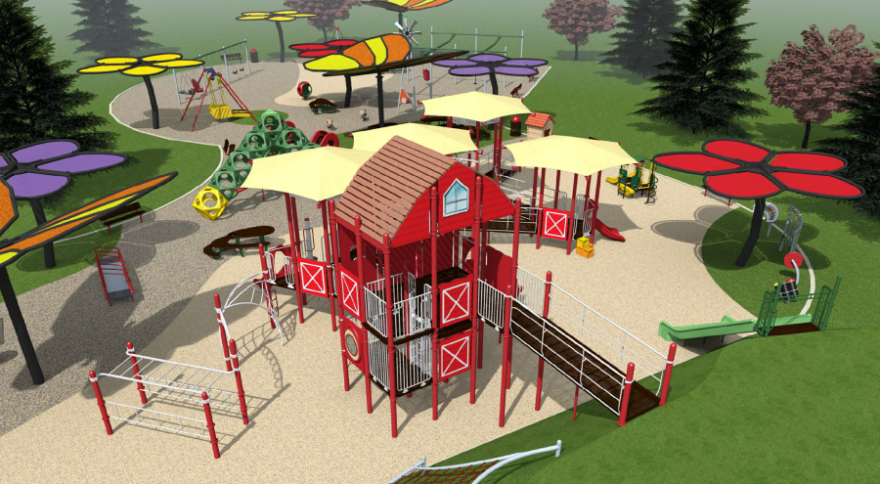It’s a sunny May day in Berthoud, Colo., just an hour north of Denver. Lauren Bowling and her 5-year-old son, Miles, are heading to their neighborhood park.
“It’s so hot I’m gonna turn into a sun!” Miles yelled, squinting at the light.
Miles loves the park and can’t wait to get there. He uses his wheelchair to rush ahead of his two brothers.
“Are you going down by yourself?” Bowling asked.
“Yeah!" hollered Miles as he rolled down the driveway. “Whee!”
But when his brothers run to the playground's slides and monkey bars, Miles stops on the sidewalk. His mom can’t push his wheelchair over the mulch-like wood pieces.
“That sucks, I can’t even push him on there,” Bowling said. “This is ADA compliant. This is what the ADA says is accessible.”
So she lifts Miles out of his chair and carries him – something she won’t be able to do for much longer as he grows.
“This is what an non-accessible playground looks like for us,” she said. “And I'm exhausted by the end.”
This is a common problem for Miles that goes back to when he was born. He and his twin brother, Mack, were born three months early and had to be resuscitated at birth. But Miles was without oxygen for too long, which caused periventricular leukomalacia, or PVL, a form of brain damage. At age 2 he was diagnosed with cerebral palsy.
“We had the benefit of identical twins, so we watched as Mack rolled over and Miles didn't, we watched as Mack sat up and Miles didn't meet that milestone,” Bowling said. “We knew that something wasn't quite right.”
Miles has no cognitive or verbal issues, but he has to use a wheelchair.
“We have a five-year-old who doesn't always understand why his body can't do the things that he wants it to do and can tell us just how frustrated he is,” she said. “And that breaks my heart.”
There are dozens of accessible parks around the Mountain West, with some of the newest being Sparks Marina Playground in Nevada, Bowden Park Playground in Idaho and the Draper Park Playground in Utah.
But not all parks are inclusive, Bowling explained. She said there can be a big difference. Some parks may only have one swing or ramped play structure with no interactive features.
“They'll label them as accessible just because they have a swing, which most playgrounds do at least have a swing right now,” Bowling said. “It’s just not enough. And I know that children in wheelchairs and people with disabilities are the minority. But we've just got to do better for inclusion. We just do.”
Other parks may utilize engineered wood fiber or similar materials for surfacing, which, while it is ADA Compliant, can be difficult to navigate with a wheelchair. The National Center on Accessibility ran a study in 2012 and found that a year after installation, playgrounds that use engineered wood fiber had the greatest number of deficiencies.
Bowling said this happens often when they travel to parks.
“We'll be so excited, we'll get there [and] his brothers can run around all of the stuff,” she said. “Miles can't actually do anything other than roll around on the ground. You can visibly see him just deflate and be so bummed out. And it's almost worse than going to a playground that is completely inaccessible and him knowing that…he's going to need me to get him out of his wheelchair and carry him.”
She’s found a few Colorado parks that are wheelchair-accessible, like Inspiration Playground in Fort Collins and Avens Village Playground in Greeley. But they’re 45 minutes away – a whole day affair.
So when she noticed a small pocket park being built by the developer of her family’s new neighborhood, she called the developer, Will Edwards.
“I said, ‘Hi, my name's Lauren. I'm a mom. I have a child in a wheelchair, and I wanted to talk to you about the neighborhood spaces, the community spaces, and I want to talk to you about the accessibility of them,’” she said.
Although he had already bought all the equipment for the park, Edwards agreed to add an ADA-accessible swing to the park – on the condition that Bowling match him dollar-for-dollar for the $9,000 swing, according to Bowling.
So, Miles and his mother set up what most kids do to raise money – a lemonade stand. Bowling spread the word over social media and people showed up in droves to give donations, including other parents of kids with disabilities.

“We did it over two days and we raised $11,000,” she said. “I can't even put it into words. My heart was so full.”
That $11,000 caught Edwards’ attention, and he decided a bigger park was in order. So, in 2021, they launched the Berthoud Adaptive Park Project with the goal of raising around $1 million for their dream playground, in partnership with the Longmont-based nonprofit Can’d Aid. They're over halfway to their goal — so far, they have raised $503,182.48.
Alyssa Lile is the director of programs at Can’d Aid, which mobilizes volunteers to respond to community needs, from water access to music programs.
“It just became clear that there is just not enough accessibility and inclusion and not necessarily because of a lack of caring about it, but there's that exorbitant cost associated with making things inclusive,” Lile said. “And I think a lot of times [for] developers and designers…it's not top of mind."
Although this is the first time Can’d Aid has done a project like this, the park is part of its Treads and Trails program, which is all about promoting healthy active outlets for underserved youth.
“I think it's extremely important for all kids, no matter what type of kids they are, to get out and have active, active play,” Lile said. “It's good for your brain, for your heart. It's definitely good for mental health to be able to get outside…. It's much more difficult for a kid to enjoy inclusive play if he's in a wheelchair and he can't even get on to the playground.”
To plan the park, Bowling contacted moms and disability organizations on Facebook to see what the community desired for inclusive park equipment – and not just for kids in wheelchairs.
“I think that we really tried to incorporate and consider all needs and all disabilities, and I really hope that when it comes to fruition, that it's something that is inclusive play, side by side, for everybody,” she said.
Erin Starr is the COO of Star Playgrounds in Littleton, Colo. She’s a certified inclusive play designer and is helping to add more than just ramps and swings to the new Berthoud park.
“We don't just want to create something because it's cool,” Starr said. “We want to create something because there is an inclusive factor to it…. [It] really makes you think differently about where you put stuff, why you put it there, and who are you serving through design and placement of equipment.
“That's what inclusion is about – it's about breeding empathy, playing together and not creating these others that are out there.”
The Berthoud park will include a ramped farm structure that is two stories high. It will also have a harnessed zipline for racing, lower monkey bars and a roller table that kids can reach in a wheelchair. Some of its more unique features include textured sidewalks and an interactive play arch, which is a large motion-sensing bow over a platform that's loaded with various games and activities like dancing.
While most donations to the Berthoud Adaptive Park Project are from businesses or organizations, other kids are joining in to help make the park a reality.
“One girl, even, she's raised over $1,000…just because she is so, so inspired by this project and by Miles,” Lile said.
Bowling said all it takes to pull off community efforts like these is for someone to step up.
“I'm just a mom who saw an opportunity,” she said. “I made a phone call and it led to this. And I'm so grateful that so many people said, ‘Yes.’ That’s how it turned into this incredible thing.”
In the meantime, Miles will rely on his mom to play and go down slides as he eagerly awaits the new playground.
“Meet me at the bottom,” Miles said to his mom.
“Okay, go! Whooo!” Bowling replied as Miles slid down.
“Again!” he shouted.
The park has run into a few problems since it was first proposed. Starr said the budget now is about $1.2 million, partly due to inflation. And other logistics have been challenging. But construction is still slated to start as early as this fall with the playground opening by the end of next year.
The Bowlings are hosting another lemonade stand fundraiser on June 10 and 11th in Berthoud. For more information, visit Can’d Aid’s website.
This story was produced by the Mountain West News Bureau, a collaboration between Wyoming Public Media, Nevada Public Radio, Boise State Public Radio in Idaho, KUNR in Nevada, the O'Connor Center for the Rocky Mountain West in Montana, KUNC in Colorado, KUNM in New Mexico, with support from affiliate stations across the region. Funding for the Mountain West News Bureau is provided in part by the Corporation for Public Broadcasting.
Copyright 2023 KUNC. To see more, visit KUNC. 9(MDA1MTkyNjA1MDEyNzM1MTQ0ODk3NTA1NA004))




